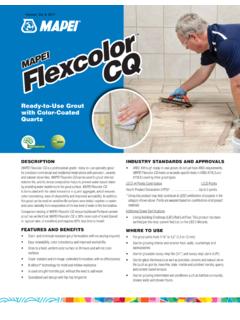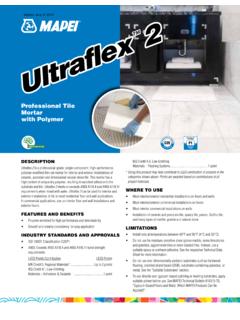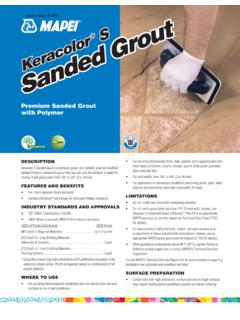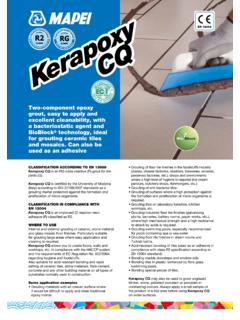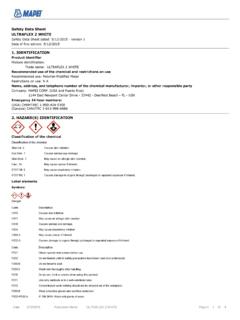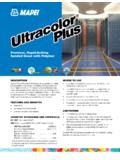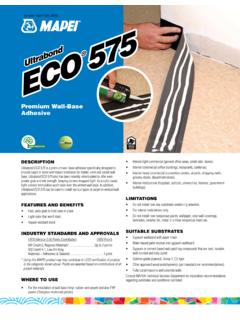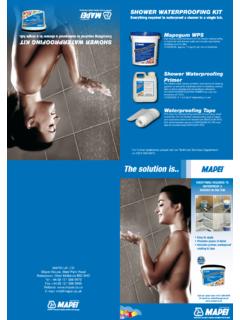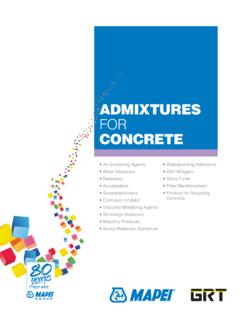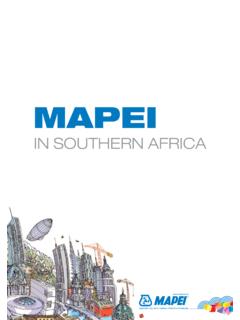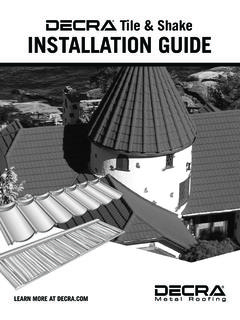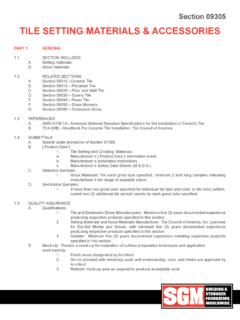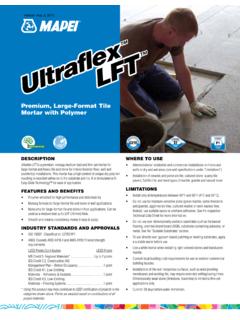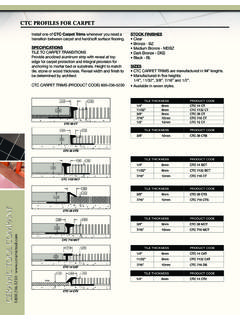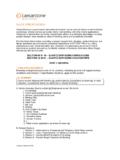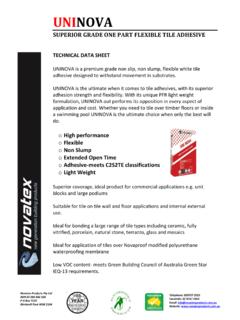Transcription of Premium, Large-and-Heavy- Tile Mortar with Polymer
1 DESCRIPTIONU ltraflex LFT is a premium, nonsag, Large-and-Heavy- tile Mortar (formerly known as medium-bed Mortar ) and thin-set Mortar designed for large-format and heavy tile and stone for interior/exterior floor, wall and countertop installations. This Mortar has a high content of unique dry Polymer , resulting in excellent adhesion to the substrate and tile. It is formulated with Easy Glide Technology for ease of application. FEATURES AND BENEFITS Polymer -enriched for high performance and deformability Nonsag formula for large-format tile and stone in wall applications Nonslump for large-format and heavy tile and stone in floor applications For thicker bond coats from 3/32" to 1/2" (2,5 to 12 mm) Smooth and creamy consistency makes it easy to STANDARDS AND APPROVALS ISO 13007: Classification C2 TES1P1 ANSI: Exceeds ANSI , ANSI and requirementsLEED v4 Points Contribution LEED PointsEnvironmental Product Declaration (EPD): TCNA Industry Average for Mortars*.
2 1/2 pointHealth Product Declaration (HPD)* ..Up to 2 points* Using this product may help contribute to LEED certification of projects in the categories shown above. Points are awarded based on contributions of all project TO USE Interior/exterior residential and commercial installations on floors and walls in dry and wet areas (see wall specifications under Limitations ) Installation of ceramic and porcelain tile; cultured stone; quarry tile; pavers; Saltillo tile; and most types of marble, granite and natural stone LIMITATIONS Install only at temperatures between 40 F and 95 F (4 C and 35 C). Do not use for moisture-sensitive stone (green marble; some limestone and granite), agglomerate tiles, cultured marble or resin-backed tiles. Instead, use suitable epoxy or urethane adhesives. See the respective Technical Data Sheets for more information.
3 Do not use over dimensionally unstable substrates such as hardwood flooring, oriented strand board (OSB), substrates containing asbestos, or metal. See the Suitable Substrates section. To use directly over gypsum-based patching or leveling substrates, apply a suitable primer/sealer before use. See the technical bulletin Tiling over gypsum in the Related Documents section of the Tile & Stone InstallationSystems page on MAPEI s Website. Do not use for transparent or translucent glass tile. For light-colored and translucent natural stone, a white Mortar is recommended. Consult building code requirements for use on exterior commercial building facades. Installations of tile over nonporous surfaces, such as waterproofing membranes and existing tile, may require extended setting/curing times. Dimensionally weak stone (limestone, travertine) is limited to thin-set applications , Large-and-Heavy- Tile Mortar with PolymerUltra ex LFT Ultra ex LFT March 13, 2018 SUITABLE SUBSTRATES Concrete (cured for at least 28 days) Masonry cement block, brick, cement Mortar beds, render coats and leveling coats Cement backer units (CBUs) see manufacturer s installation guidelines Gypsum wallboard and plaster interior walls in dry areas only (priming may be required).
4 See MAPEI s Surface preparation requirements reference guide in the Related Documents section of the Tile & Stone Installation Systems page on MAPEI s Website. APA Group 1 and CANPLY 0121 exterior-grade plywood (interior, residential and light-commercial floors and countertops in dry conditions only) Properly prepared vinyl composition tile (VCT), vinyl and cutback residue (interior installations) Properly prepared existing ceramic and porcelain tile, quarry tile and pavers (interior and dry conditions only) MAPEI waterproofing, crack-isolation, sound-reduction and uncoupling membranesConsult MAPEI s Technical Services Department for installation recommendations regarding substrates and conditions not PREPARATION All substrates should be structurally sound, stable, dry, clean and free of any substance or condition that may reduce or prevent proper adhesion.
5 Substrates to receive thin porcelain tiles must be perfectly flat. When installing thin-body porcelain tile, consult the recommendations regarding surface preparation, trowel selection and mechanical edge-leveling systems in MAPEI s reference guides for thin-body porcelain tile 3 to 6 mm thick for walls, and 4,5 to 6 mm thick for floors. These reference guides can be found in the Related Documents section of the Tile & Stone Installation Systems page on MAPEI s Website. See the Surface preparation requirements reference guide in the Related Documents section of the Tile & Stone Installation Systems page on MAPEI s Website. MIXINGB efore product use, take appropriate safety precautions. Refer to the Safety Data Sheet for Pour clean, potable water into a clean mixing container. 2a. For nonsag/nonslump applications: Use about to qts.
6 (6,15 to 7,10 L) of water. 2b. For MAPEI uncoupling and peel-and-stick membranes: Use about to 8 qts. (7,10 to 7,57 L) of Gradually add 50 lbs. (22,7 kg) of powder while slowly Use a low-speed mixing drill (at about 300 rpm), with an angled cross-blade mixer or auger mixer. Mix thoroughly until the mixture becomes a smooth, homogenous, lump-free paste. Avoid prolonged Let mixture stand ( slake ) for 5 If the mixture becomes heavy or stiff, remix it without adding more APPLICATIONRead all installation instructions thoroughly before Choose a notched trowel (see Approximate Coverage chart) with sufficient depth to achieve greater than 85% Mortar contact to both the tile and substrate for all interior applications, and greater than 95% for exterior installations, commercial floor and wet applications. It may be necessary to back-butter the tile in order to meet these requirements.
7 (Refer to ANSI specifications and TCNA handbook guidelines.)2. With pressure, apply a coat by using the trowel s flat side to key the Mortar into the Apply additional Mortar , combing it in a single direction parallel to the tile s shortest dimension, with the trowel s notched side. If thin tile is being installed, it should be placed so that the troweled ridges on its back are oriented in the same parallel direction as the trowel ridges on the Spread only as much Mortar as can be tiled before the product skins over. Open time can vary with jobsite Place the tiles firmly into the wet Mortar . Push the tiles back and forth in a direction perpendicular to trowel lines, to collapse the Mortar ridges and help achieve maximum coverage. Ensure proper contact between the Mortar , tile and substrate by periodically lifting a few tiles to check for acceptable Remove excess Mortar from the joint areas so that at least 2/3 of the tile depth is available for grouting (see ANSI guidelines).
8 EXPANSION AND CONTROL JOINTS Provide for expansion and control joints as specified per TCNA Method EJ171 or TTMAC Specification Guide 09 30 00, Detail 301MJ. Do not cover expansion joints with Clean tools and tile while the Mortar is fresh, using only Do not disturb the installation, allow light traffic or grout any tiles for at least 24 to 48 hours. Protect the installation from general traffic for at least 72 hours, and from heavy traffic for at least 7 days. Protect the installation from rain for 72 hours, and from freezing for 21 days. Cure for 28 days before water immersionNote: When working in cold temperatures, protect tilework for an extended time for this dry-set Mortar to cure before grouting and/or allowing ex LFT Ultra ex LFT Ultra ex LFT Ultra ex LFT ISO 13007 ClassificationClassification CodeClassification RequirementTest Characteristic C2 (cementitious, improved adhesive) 145 psi (1 MPa) after standard aging, heat aging, water immersion and freeze/thaw cyclesUsing porcelain tileT (vertical slip resistance) " (0,5 mm)Using porcelain tileE (extended open time) psi (0,5 MPa) after 30 minutesUsing glazed ceramic wall tileS1 (normal deformation of Mortar ) " (2,5 mm)-----------P1 (normal adhesion to plywood) psi (0,5 MPa)
9 Using porcelain tileANSI Specification*Test MethodSpecification StandardTest ResultsANSI shear strength, quarry tile to plywood> 150 psi (1,03 MPa) at 28 days170 to 310 psi (1,17 to 2,14 MPa)ANSI extended open time psi (0,5 MPa) at 30 minutesPassANSI shear strength, impervious ceramic (porcelain) mosaics> 400 psi (2,76 MPa) at 28 daysPassANSI shear strength, glazed wall tile > 450 psi (3,10 MPa) at 7 days 570 to 780 psi (3,93 to 5,38 MPa)ANSI shear strength, quarry tile to quarry tile> 150 psi (1,03 MPa) at 28 days310 to 450 psi (2,14 to 3,10 MPa)ANSI sag on vertical surfaces< " (0,5 mm) at 20 minutesPass* Anything that meets by definition exceeds Life and Application Properties (before mixing)Shelf life1 year when stored in original, unopened packaging at 73 F (23 C)ColorsGray, whiteApplication Properties at 73 F (23 C) and 50% relative humidityOpen time**30 to 35 minutesPot life**4 hoursTime before grouting (walls)**8 to 16 hoursTime before grouting (floors)**24 hoursVOCs (Rule #1168 of California s SCAQMD)0 g per L** Open time, pot life and time before grouting vary based on jobsite and ColorBag: 50 lbs.
10 (22,7 kg), grayBag: 50 lbs. (22,7 kg), whiteWe proudly support the following industry organizations:MAPEI Headquarters of North America1144 East Newport Center Drive Deerfield Beach, Florida 33442 1-888-US-MAPEI (1-888-876-2734) / (954) 246-8888 Technical Services1-800-992-6273 ( and Puerto Rico) 1-800-361-9309 (Canada)Customer Service1-800-42-MAPEI (1-800-426-2734) Services in Mexico0-1-800-MX-MAPEI (0-1-800-696-2734)Edition Date: March 8, 2018PR: 5627 MKT: 18-1224 For the most current BEST-BACKEDSM product data and warranty information, visit Rights Reserved. Printed in the USA. 2018 MAPEI DOCUMENTS Reference Guide: Surface preparation requirements for tile and stone installation systems**Technical Bulletin: Tiling over gypsum ** At to the SDS for specific data related to health and safety as well as product A L NOTICE The contents of this Technical Data Sheet ( TDS ) may be copied into another project-related document, but the resulting document shall not supplement or replace requirements per the TDS in effect at the time of the MAPEI product installation.
